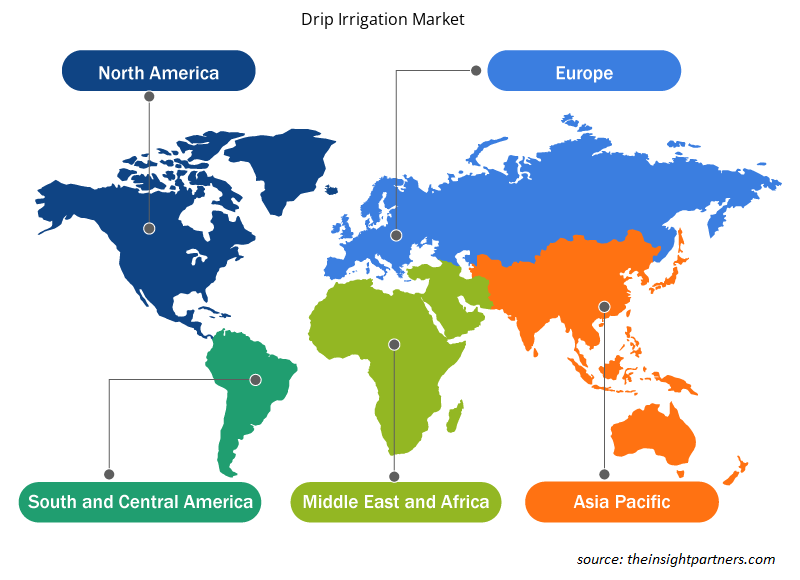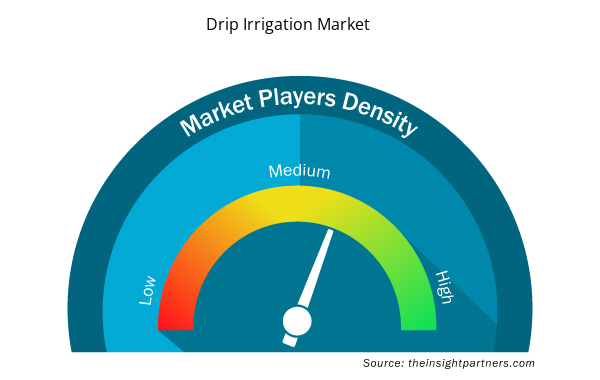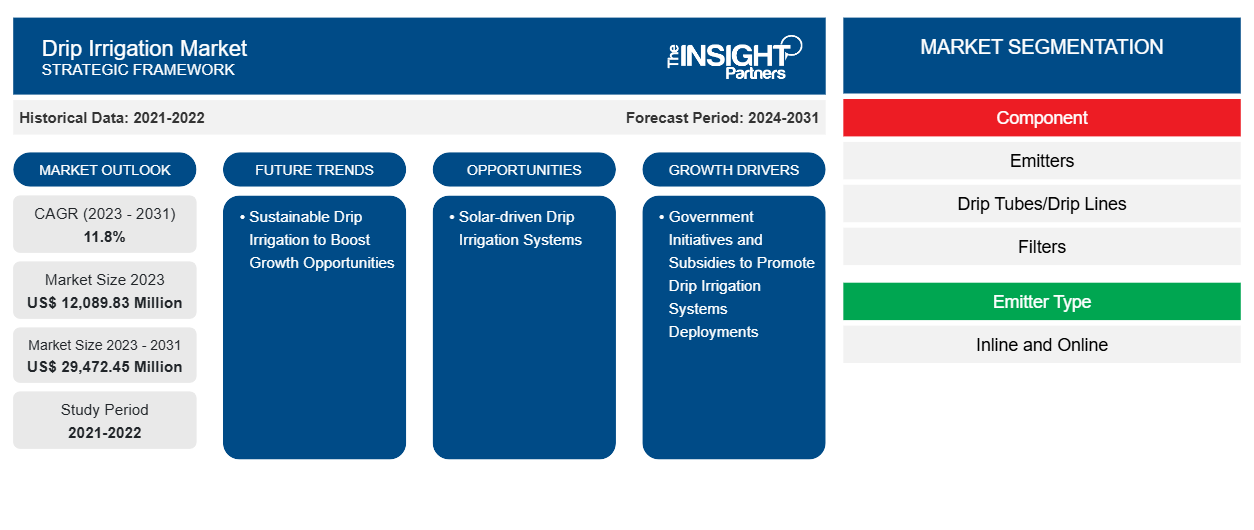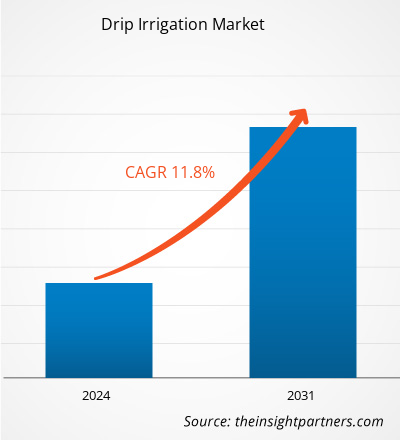Der Markt für Tropfbewässerung wird voraussichtlich von 12.089,83 Millionen US-Dollar im Jahr 2023 auf 29.472,45 Millionen US-Dollar im Jahr 2031 anwachsen. Der Markt wird zwischen 2023 und 2031 voraussichtlich eine durchschnittliche jährliche Wachstumsrate von 11,8 % verzeichnen. Die zunehmende Verbreitung solarbetriebener Tropfbewässerungssysteme dürfte ein wichtiger Trend auf dem Markt bleiben.
Marktanalyse für Tropfbewässerung
Die wachsende Nachfrage nach einem CO2-freien, technologisch fortschrittlichen Mikrobewässerungssystem, das auf Farmen jeder Größe gut funktioniert und mithilfe der vorhandenen Feldinfrastruktur installiert werden kann, treibt das Wachstum des globalen Tropfbewässerungsmarktes voran. Die Entwicklung des Tropfbewässerungsmarktes wird mehreren Vorteilen der Tropfbewässerung zugeschrieben, wie z. B. gesteigerter Pflanzenproduktivität und verbesserter Qualität, Krankheitsvorbeugung durch Verringerung des Wasserkontakts mit den Blättern, verringertem Unkrautwachstum und geringerem Arbeitsaufwand.
Marktübersicht für Tropfbewässerung
Zu den wichtigsten Akteuren im globalen Ökosystem des Tropfbewässerungsmarktes zählen Rohstofflieferanten, Tropfbewässerungshersteller und Endverbraucher. Der Rohstofflieferant ist ein wichtiger Akteur im Ökosystem des Tropfbewässerungsmarktes. Die Tropfbewässerungshersteller sind Jain Irrigation, Netafim, Lindsay Corp, Hunter Industries und Rain Bird Industries. Zu den wichtigsten Endverbrauchern des Tropfbewässerungsmarktes zählen Landwirtschaft , Gewächshäuser und andere.
Passen Sie diesen Bericht Ihren Anforderungen an
Sie erhalten kostenlos individuelle Anpassungen an jedem Bericht, einschließlich Teilen dieses Berichts oder einer Analyse auf Länderebene, eines Excel-Datenpakets sowie tolle Angebote und Rabatte für Start-ups und Universitäten.
- Holen Sie sich die wichtigsten Markttrends aus diesem Bericht.Dieses KOSTENLOSE Beispiel umfasst eine Datenanalyse von Markttrends bis hin zu Schätzungen und Prognosen.
Treiber und Chancen auf dem Markt für Tropfbewässerung
Staatliche Initiativen und Subventionen zur Förderung des Einsatzes von Tropfbewässerungssystemen zur Förderung des Marktes
Die Regierungen verschiedener Entwicklungsländer wie Indien beschlossen, Landwirte finanziell zu unterstützen, und starteten eine Sensibilisierungskampagne, um möglichst viele Landwirte zu ermutigen, auf Tropf- und Sprinklerbewässerungsmethoden umzusteigen. Die Regierung von Maharashtra, Indien, beschloss, die Subventionen zur Förderung von Mikrobewässerungssystemen im Jahr 2021 zu erhöhen. Landwirte setzen neuartige Technologien wie die Sprinklerbewässerung ein, was die Entwicklung von Mikrobewässerungssystemen in ganz Deutschland erheblich vorantreibt. Daher wirkt der zunehmende Fokus der Regierung auf Bewässerungssysteme als wichtiger Treiber für den Markt.
Solarbetriebene Tropfbewässerungssysteme
Die zunehmende Einbindung fortschrittlicher Technologien in kleine Bewässerungsprojekte zur Milderung der negativen Auswirkungen des Klimawandels und der zunehmenden Dürreperioden dürfte dem Markt für Tropfbewässerung erhebliche Expansionsmöglichkeiten eröffnen. Das zunehmende Bewusstsein für die Vorteile der Tropfbewässerung zur Verbesserung des Wirtschaftswachstums, ein Anstieg der Programme im privaten Sektor sowie erweiterte staatliche Finanzierungsmöglichkeiten und Kredite für Landwirte zur Nutzung dieser Technologien werden den Markt für Tropfbewässerung voraussichtlich zwischen 2023 und 2031 vergrößern.capitalise in these technologies are predicted to increase the drip irrigation market size from 2023 to 2031.
Segmentierungsanalyse des Marktberichts zur Tropfbewässerung
Wichtige Segmente, die zur Ableitung der Marktanalyse für Tropfbewässerung beigetragen haben, sind Komponente, Emittertyp, Anwendung und Typ.
- Basierend auf der Komponente ist der Markt für Tropfbewässerung in Emitter, Tropfschläuche/Tropfleitungen, Filter, Ventile, Druckpumpen und andere unterteilt. Das Emittersegment hatte im Jahr 2023 einen größeren Marktanteil.
- Basierend auf dem Emittertyp ist der Markt für Tropfbewässerung in Inline- undonline. Das Online-Segment hatte im Jahr 2023 einen größeren Marktanteil.
- Nach Anwendung ist der Markt in Landwirtschaft, Gewächshäuser und andere unterteilt. Das Agrarsegment hielt im Jahr 2023 einen bedeutenden Marktanteil.
- Nach Typ ist der Markt in Oberflächen- und Untergrundsegmente unterteilt. Das Untergrundsegment hielt im Jahr 2023 einen erheblichen Marktanteil.
Tropfbewässerung Marktanteilsanalyse nach Geografie
Der geografische Umfang des Marktberichts zur Tropfbewässerung ist hauptsächlich in fünf Regionen unterteilt: Nordamerika, Asien-Pazifik, Europa, Naher Osten und Afrika sowie Süd- und Mittelamerika.
Der asiatisch-pazifische Raum ist Marktführer. Der asiatisch-pazifische Raum ist eine dicht besiedelte Region der Welt mit einem höheren Energiebedarf. Der asiatisch-pazifische Raum ist zusammen mit China und Indien eine der sich entwickelnden Wirtschaftsregionen. Japan ist eines der technologisch fortschrittlichsten Länder der Region und unterstützt die Entwicklung eines Marktes für Tropfbewässerung. Nordamerika ist eine technologisch fortschrittliche Region. Intelligente Technologien haben in dieser Region eine hohe Akzeptanz erfahren. In Kombination mit Tropfbewässerungssystemen bieten diese Technologien den Endnutzern Effizienz. Weitere Einsätze erfordern mehr Wettbewerb in der Region und das Wachstum des gesamten Marktes führt zu Marktentwicklung und Innovationen.
Regionale Einblicke in den Markt für Tropfbewässerung
Die regionalen Trends und Faktoren, die den Markt für Tropfbewässerung im Prognosezeitraum beeinflussen, wurden von den Analysten von Insight Partners ausführlich erläutert. In diesem Abschnitt werden auch die Marktsegmente und die Geografie für Tropfbewässerung in Nordamerika, Europa, im asiatisch-pazifischen Raum, im Nahen Osten und Afrika sowie in Süd- und Mittelamerika erörtert.

- Holen Sie sich die regionalspezifischen Daten für den Tropfbewässerungsmarkt
Umfang des Marktberichts zur Tropfbewässerung
| Berichtsattribut | Details |
|---|---|
| Marktgröße im Jahr 2023 | 12.089,83 Millionen US-Dollar |
| Marktgröße bis 2031 | 29.472,45 Millionen US-Dollar |
| Globale CAGR (2023 - 2031) | 11,8 % |
| Historische Daten | 2021-2022 |
| Prognosezeitraum | 2024–2031 |
| Abgedeckte Segmente | Nach Komponente
|
| Abgedeckte Regionen und Länder | Nordamerika
|
| Marktführer und wichtige Unternehmensprofile |
|
Marktteilnehmerdichte: Der Einfluss auf die Geschäftsdynamik
Der Markt für Tropfbewässerung wächst rasant, angetrieben durch die steigende Nachfrage der Endnutzer aufgrund von Faktoren wie sich entwickelnden Verbraucherpräferenzen, technologischen Fortschritten und einem größeren Bewusstsein für die Vorteile des Produkts. Mit steigender Nachfrage erweitern Unternehmen ihr Angebot, entwickeln Innovationen, um die Bedürfnisse der Verbraucher zu erfüllen, und nutzen neue Trends, was das Marktwachstum weiter ankurbelt.
Die Marktteilnehmerdichte bezieht sich auf die Verteilung der Firmen oder Unternehmen, die in einem bestimmten Markt oder einer bestimmten Branche tätig sind. Sie gibt an, wie viele Wettbewerber (Marktteilnehmer) in einem bestimmten Marktraum im Verhältnis zu seiner Größe oder seinem gesamten Marktwert präsent sind.
Die wichtigsten auf dem Markt für Tropfbewässerung tätigen Unternehmen sind:
- Hunter Industries
- IRRITEC SPA
- Lindsay Corporation
- Netafim
- Rain Bird Corporation
- Die Toro Company
Haftungsausschluss : Die oben aufgeführten Unternehmen sind nicht in einer bestimmten Reihenfolge aufgeführt.

- Überblick über die wichtigsten Akteure auf dem Markt für Tropfbewässerung
Neuigkeiten und aktuelle Entwicklungen zum Markt für Tropfbewässerung
Der Markt für Tropfbewässerung wird durch die Erhebung qualitativer und quantitativer Daten nach Primär- und Sekundärforschung bewertet, die wichtige Unternehmensveröffentlichungen, Verbandsdaten und Datenbanken umfasst. Nachfolgend sind einige der Entwicklungen auf dem Markt für Tropfbewässerung aufgeführt:
- Die Toro Company hat ihre Produktlinie Toro Aqua-Traxx Azul zur Präzisionsbewässerung erweitert. Zur Verbesserung der Leistung wurden Ultra-Low-Flow-Optionen hinzugefügt. (Quelle: The Toro Company, Pressemitteilung, März 2022)
- Rivulis Irrigation Ltd. hat seine hochmoderne Fabrik in Nordamerika eröffnet. Damit wird die Kapazität der nordamerikanischen Fertigung erweitert. (Quelle: Rivulis Irrigation Ltd, Pressemitteilung, April 2022)
Marktbericht zur Tropfbewässerung – Umfang und Ergebnisse
Der Bericht „Marktgröße und Prognose für Tropfbewässerung (2021–2031)“ bietet eine detaillierte Analyse des Marktes, die die folgenden Bereiche abdeckt:
- Tropfbewässerungsmarktgröße und -prognose auf globaler, regionaler und Länderebene für alle wichtigen Marktsegmente, die im Rahmen des Berichts abgedeckt sind
- Markttrends und Marktdynamiken für Tropfbewässerung wie Treiber, Einschränkungen und wichtige Chancen
- Detaillierte PEST- und SWOT-Analyse
- Marktanalyse für Tropfbewässerung mit wichtigen Markttrends, globalen und regionalen Rahmenbedingungen, wichtigen Akteuren, Vorschriften und aktuellen Marktentwicklungen
- Branchenlandschaft und Wettbewerbsanalyse, einschließlich Marktkonzentration, Heatmap-Analyse, prominenten Akteuren und aktuellen Entwicklungen auf dem Markt für Tropfbewässerung
- Detaillierte Firmenprofile
- Historische Analyse (2 Jahre), Basisjahr, Prognose (7 Jahre) mit CAGR
- PEST- und SWOT-Analyse
- Marktgröße Wert/Volumen – Global, Regional, Land
- Branche und Wettbewerbsumfeld
- Excel-Datensatz


- Digital Language Learning Market
- Environmental Consulting Service Market
- Nitrogenous Fertilizer Market
- Third Party Logistics Market
- Excimer & Femtosecond Ophthalmic Lasers Market
- Identity Verification Market
- Artwork Management Software Market
- Parking Management Market
- Photo Editing Software Market
- Vertical Farming Crops Market

Report Coverage
Revenue forecast, Company Analysis, Industry landscape, Growth factors, and Trends

Segment Covered
This text is related
to segments covered.

Regional Scope
North America, Europe, Asia Pacific, Middle East & Africa, South & Central America

Country Scope
This text is related
to country scope.
Häufig gestellte Fragen
Asia Pacific dominated the drip irrigation market in 2023.
The sustainable drip irrigation is the future trend of the Drip Irrigation market.
Hunter Industries, IRRITEC S.P.A., Netafim, Lindsay Corporation, Rain Bird Corporation, The Toro Company, Chinadrip Irrigation Equipment Co., Ltd., Microjet, Rivulis Irrigation Ltd., Jain Irrigation Systems Ltd. are some of the leading players in the market.
US$ 29,472.45 million estimated value of the drip irrigation market by 2031.
11.8% is the expected CAGR of the drip irrigation market.
Trends and growth analysis reports related to Manufacturing and Construction : READ MORE..
The Insight Partners performs research in 4 major stages: Data Collection & Secondary Research, Primary Research, Data Analysis and Data Triangulation & Final Review.
- Data Collection and Secondary Research:
As a market research and consulting firm operating from a decade, we have published and advised several client across the globe. First step for any study will start with an assessment of currently available data and insights from existing reports. Further, historical and current market information is collected from Investor Presentations, Annual Reports, SEC Filings, etc., and other information related to company’s performance and market positioning are gathered from Paid Databases (Factiva, Hoovers, and Reuters) and various other publications available in public domain.
Several associations trade associates, technical forums, institutes, societies and organization are accessed to gain technical as well as market related insights through their publications such as research papers, blogs and press releases related to the studies are referred to get cues about the market. Further, white papers, journals, magazines, and other news articles published in last 3 years are scrutinized and analyzed to understand the current market trends.
- Primary Research:
The primarily interview analysis comprise of data obtained from industry participants interview and answers to survey questions gathered by in-house primary team.
For primary research, interviews are conducted with industry experts/CEOs/Marketing Managers/VPs/Subject Matter Experts from both demand and supply side to get a 360-degree view of the market. The primary team conducts several interviews based on the complexity of the markets to understand the various market trends and dynamics which makes research more credible and precise.
A typical research interview fulfils the following functions:
- Provides first-hand information on the market size, market trends, growth trends, competitive landscape, and outlook
- Validates and strengthens in-house secondary research findings
- Develops the analysis team’s expertise and market understanding
Primary research involves email interactions and telephone interviews for each market, category, segment, and sub-segment across geographies. The participants who typically take part in such a process include, but are not limited to:
- Industry participants: VPs, business development managers, market intelligence managers and national sales managers
- Outside experts: Valuation experts, research analysts and key opinion leaders specializing in the electronics and semiconductor industry.
Below is the breakup of our primary respondents by company, designation, and region:

Once we receive the confirmation from primary research sources or primary respondents, we finalize the base year market estimation and forecast the data as per the macroeconomic and microeconomic factors assessed during data collection.
- Data Analysis:
Once data is validated through both secondary as well as primary respondents, we finalize the market estimations by hypothesis formulation and factor analysis at regional and country level.
- Macro-Economic Factor Analysis:
We analyse macroeconomic indicators such the gross domestic product (GDP), increase in the demand for goods and services across industries, technological advancement, regional economic growth, governmental policies, the influence of COVID-19, PEST analysis, and other aspects. This analysis aids in setting benchmarks for various nations/regions and approximating market splits. Additionally, the general trend of the aforementioned components aid in determining the market's development possibilities.
- Country Level Data:
Various factors that are especially aligned to the country are taken into account to determine the market size for a certain area and country, including the presence of vendors, such as headquarters and offices, the country's GDP, demand patterns, and industry growth. To comprehend the market dynamics for the nation, a number of growth variables, inhibitors, application areas, and current market trends are researched. The aforementioned elements aid in determining the country's overall market's growth potential.
- Company Profile:
The “Table of Contents” is formulated by listing and analyzing more than 25 - 30 companies operating in the market ecosystem across geographies. However, we profile only 10 companies as a standard practice in our syndicate reports. These 10 companies comprise leading, emerging, and regional players. Nonetheless, our analysis is not restricted to the 10 listed companies, we also analyze other companies present in the market to develop a holistic view and understand the prevailing trends. The “Company Profiles” section in the report covers key facts, business description, products & services, financial information, SWOT analysis, and key developments. The financial information presented is extracted from the annual reports and official documents of the publicly listed companies. Upon collecting the information for the sections of respective companies, we verify them via various primary sources and then compile the data in respective company profiles. The company level information helps us in deriving the base number as well as in forecasting the market size.
- Developing Base Number:
Aggregation of sales statistics (2020-2022) and macro-economic factor, and other secondary and primary research insights are utilized to arrive at base number and related market shares for 2022. The data gaps are identified in this step and relevant market data is analyzed, collected from paid primary interviews or databases. On finalizing the base year market size, forecasts are developed on the basis of macro-economic, industry and market growth factors and company level analysis.
- Data Triangulation and Final Review:
The market findings and base year market size calculations are validated from supply as well as demand side. Demand side validations are based on macro-economic factor analysis and benchmarks for respective regions and countries. In case of supply side validations, revenues of major companies are estimated (in case not available) based on industry benchmark, approximate number of employees, product portfolio, and primary interviews revenues are gathered. Further revenue from target product/service segment is assessed to avoid overshooting of market statistics. In case of heavy deviations between supply and demand side values, all thes steps are repeated to achieve synchronization.
We follow an iterative model, wherein we share our research findings with Subject Matter Experts (SME’s) and Key Opinion Leaders (KOLs) until consensus view of the market is not formulated – this model negates any drastic deviation in the opinions of experts. Only validated and universally acceptable research findings are quoted in our reports.
We have important check points that we use to validate our research findings – which we call – data triangulation, where we validate the information, we generate from secondary sources with primary interviews and then we re-validate with our internal data bases and Subject matter experts. This comprehensive model enables us to deliver high quality, reliable data in shortest possible time.


 Holen Sie sich ein kostenloses Muster für diesen Bericht
Holen Sie sich ein kostenloses Muster für diesen Bericht